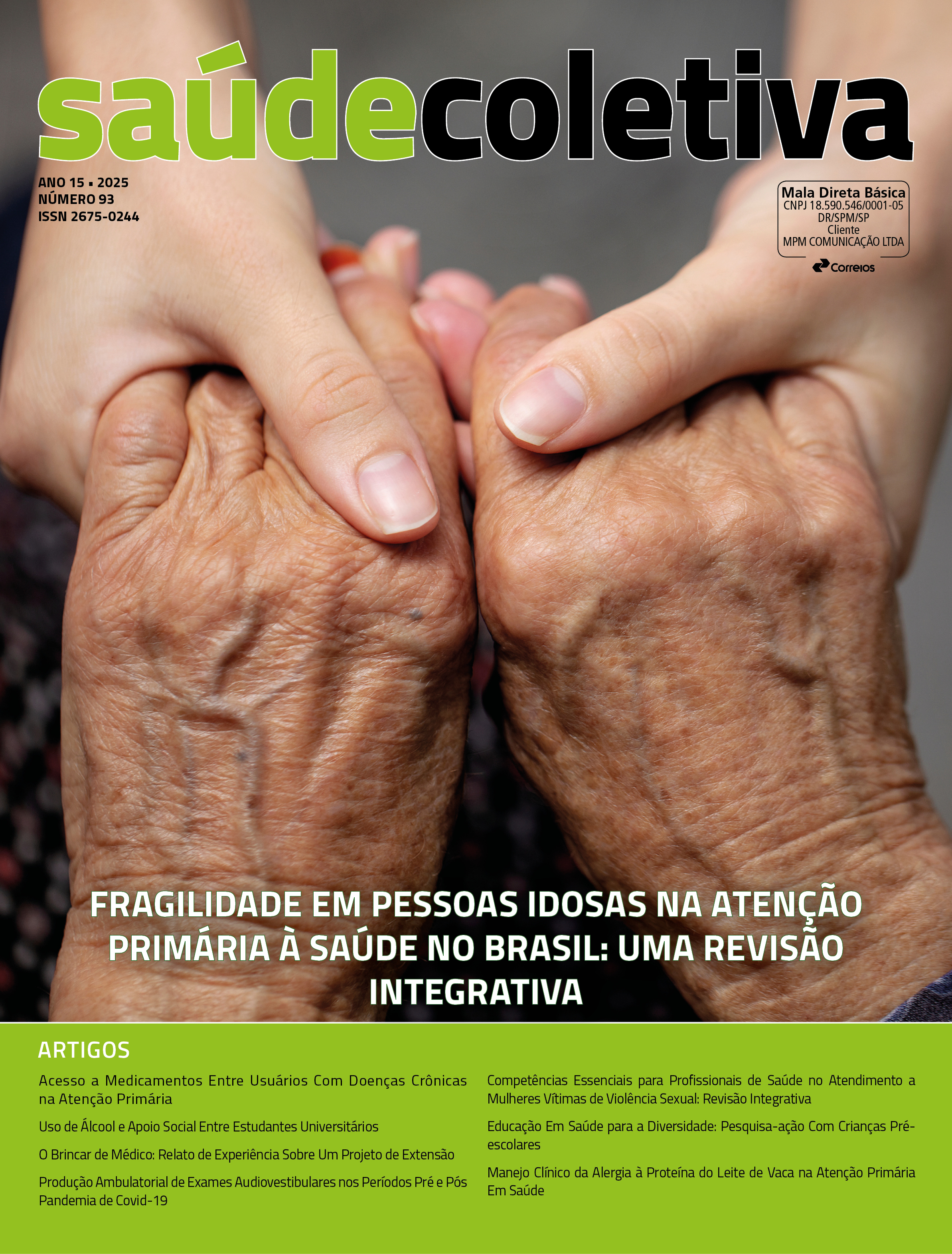Age Is Protective While Economical Punctuation and Body Image Are Risk Factors to Body Concern
DOI:
https://doi.org/10.36489/saudecoletiva.2025v15i93p14733-14750Keywords:
Eating behavior, Body image, Students, Physical Appearance, BodyAbstract
This study investigates the impact of socioeconomic, academic, anthropometric, behavioral, and body image factors on body concerns among female undergraduate nutrition students. Conducted in the Midwest region of Brazil, it involved 173 nutrition students. Data on sociodemographic, academic, anthropometric, behavioral, and body image (using the Stunkard Figure Rating Scale, Food Desire Questionnaire, and Body Shape Questionnaire) were collected. Results revealed that 46.24% of students had some level of body concern, with 10.98% experiencing severe concerns. Economic status (p=0.02) and anthropometric variables (p=0.01) were associated to body concern levels. The incremental in the age in such way that one year older represents less chance of being concerned (OR=0.84;IC95%:0.72-0.98). There is a higher chance of being concerned of their bodies with the incremental of economical punctuation represents higher chance (1.07;1.03-1.12) and Stunkard Figure Rating Scale (2.10;1.34-3.28). It emphasizes the importance of implementing interventions that address Nutrition students' body concerns.
References
Kapoor A, Upadhyay M, Saini N. Prevalence, patterns, and determinants of body image dissatisfaction among female undergraduate students of University of Delhi. J Fam Med Prim Care. 2022;11(5):2002–7. doi: 10.4103/jfmpc.jfmpc_1851_21.
Hosseini SA, Padhy RK. Body Image Distortion. Treasure Island (FL): StatPearls Publishing; 2024.
Lôbo ILB, Mello MTD, Oliveira JRVD, Cruz MP, Guerreiro RDC, Silva A. Body image perception and satisfaction in university students. Rev Bras Cineantropometria Desempenho Hum. 2020;22:e70423. doi: 10.1590/1980-0037.2020v22e70423.
Thangaraju S, Karpagalakshmi R, Arumuganathan S, Usaid S, Devi Ss, Sethumadhavan V. A cross-sectional study on prevalence of eating disorder and body image disturbance among female undergraduate medical students. J Ment Health Hum Behav. 2020;25(1):53–6. doi: 10.4103/jmhhb.jmhhb_13_20.
Schaefer LM, Thompson JK. Self-objectification and disordered eating: A meta-analysis. Int J Eat Disord. 2018;51(6):483–502. doi: 10.1002/eat.22854.
Silva LPR da, Tucan AR de O, Rodrigues EL, Del Ré PV, Sanches PMA, Bresan D. Dissatisfaction about body image and associated factors: A study of young undergraduate students. Einstein (São Paulo). 2019;17(4):eAO4642. doi: 10.31744/einstein_journal/2019AO4642.
Aparicio-Martinez P, Perea-Moreno AJ, Martinez-Jimenez M, Redel-Macías MD, Pagliari C, Vaquero-Abellan M. Social media, thin-ideal, body dissatisfaction and disordered eating attitudes: an exploratory analysis. Int J Environ Res Public Health. 2019;16(21):4177. doi: 10.3390/ijerph16214177.
Chin YS, Appukutty M, Kagawa M, Gan WY, Wong JE, Poh BK. Comparison of factors associated with disordered eating between male and female Malaysian university students. Nutrients. 2020;12(2):318. doi: 10.3390/nu12020318.
Assis LCD, Guedine CRDC, Carvalho PHBD. Social media use and its association with disordered eating among Nutrition Science students. J Bras Psiquiatr. 2020;69(4):220–7. doi: 10.1590/0047-2085000000288.
Hoteit M, Mohsen H, Bookari K, Moussa G, Jurdi N, Yazbeck N. Prevalence, correlates, and gender disparities related to eating disordered behaviors among health science students and healthcare practitioners in Lebanon: Findings of a national cross-sectional study. Front Nutr. 2022;9:956310. doi: 10.3389/fnut.2022.956310.
Cassiano GS, Carvalho-Ferreira JP, Buckland NJ, Ulian MD, Da Cunha DT. Are dietitians with obesity perceived as competent and warm? Applying the stereotype content model to weight stigma in Brazil. Front Nutr. 2022;9:813344. doi: 10.3389/fnut.2022.813344.
Lopes CM, Junior OMR. The influence of the media on the eating behavior of adolescents: Eating disorders anorexia nerviosa and bulimia nerviosa. Res Soc Dev. 2022;11(13):e404111335648. doi: 10.33448/rsd-v11i13.35648.
Weinberger NA, Kersting A, Riedel-Heller SG, Luck-Sikorski C. Body dissatisfaction in individuals with obesity compared to normal-weight individuals: A systematic review and meta-analysis. Obes Facts. 2016;9(6):424–41. doi: 10.1159/000454837.
Silva JD, Silva ABJ, Oliveira AVK, Nemer ASA. Influence of the nutritional status in the risk of eating disorders among female university students of nutrition: Eating patterns and nutritional status. Ciênc saúde coletiva. 2012;17(12):3399–406. doi: 10.1590/S1413-81232012001200024.
Gordon CC, Chumlea WC, Roche AF. Stature, recumbent length, and weight. In: Lohman TG, Roche AF, Martorel T, editors. Anthropometric Standardizing Reference Manual. Human Kinetics Books, Champaign, Illinois; 1988. p. 3-8. doi: 10.1249/00005768-199208000-00020.
Stunkard AJ, Sørensen T, Schulsinger F. Use of the Danish Adoption Register for the study of obesity and thinness. Res Publ - Assoc Res Nerv Ment Dis. 1983;60:115–20.
Evans SM, Foltin RW, Fischman MW. Food "cravings" and the acute effects of alprazolam on food intake in women with premenstrual dysphoric disorder. Appetite. 1999;32:331–9. doi: 10.1006/appe.1998.0222.
Souza LB, Martins KA, Cordeiro MM, Rodrigues YS, Rafacho BPM, Bomfim RA. Do food intake and food cravings change during the menstrual cycle of young women? Rev Bras Ginecol Obstet. 2018;40(11):686–92. doi: 10.1055/s-0038-1675831.
Cooper PJ, Taylor MJ, Cooper Z, Fairburn CG. The development and validation of the body shape questionnaire. Int J Eat Disord. 1987;6(4):485–94. doi: 10.1002/1098-108X(198707)6:4<485::AID-EAT2260060405>3.0.CO;2-O. Daly M, Costigan E. Trends in eating disorder risk among U.S. college students, 2013-2021. Psychiatry Res. 2022;317:114882. doi: 10.1016/j.psychres.2022.114882.
Garcia C, Castro T, Soares R. Eating behavior and body image among nutrition students at a Public University in Porto Alegre - RS. Clin Biomed Res. 2010;30(3):219-24.
Silva WR, Dias JCR, Maroco J, Campos JADB. Factors that contribute to the body image concern of female college students. Rev Bras Epidemiol. 2015;18(4):785–97. doi: 10.1590/1980-5497201500040009.
Justino MIC, Enes CC, Nucci LB. Self-perceived body image and body satisfaction of adolescents. Rev Bras Saúde Materno Infant. 2020;20(3):715–24. doi: 10.1590/1806-93042020000300004.
Moehlecke M, Blume CA, Cureau FV, Kieling C, Schaan BD. Self-perceived body image, dissatisfaction with body weight and nutritional status of Brazilian adolescents: a nationwide study. J Pediatr (Rio J). 2020;96(1):76–83. doi: 10.1016/j.jped.2018.07.006.
Daly, M., & Costigan, E. (2022). Trends in eating disorder risk among U.S. college students, 2013–2021. Psychiatry Research, 317, Article 114882. https://doi.org/10.1016/j.psychres.2022.114882
Bellard AM, Cornelissen PL, Mian E, Cazzato V. The ageing body: contributing attitudinal factors towards perceptual body size estimates in younger and middle-aged women. Arch Womens Ment Health. 2021;24(1):93–105. doi: 10.1007/s00737-020-01046-8.
Carrard I, Rothen S, Rodgers RF. Body image concerns and intuitive eating in older women. Appetite. 2021;164:105275. doi: 10.1016/j.appet.2021.105275.
Makarawung DJS, Boers MJ, Van Den Brink F, Monpellier VM, Woertman L, Mink Van Der Molen AB. The relationship of body image and weight: A cross-sectional observational study of a Dutch female sample. Clin Obes. 2023;13(1):e12569. doi: 10.1111/cob.12569.
Schwartz MB, Brownell KD. Obesity and body image. Body Image. 2004;1(1):43–56. doi: 10.1016/S1740-1445(03)00007-X.
Kantanista A, Król-Zielińska M, Borowiec J, Osiński W. Is underweight associated with more positive body image? Results of a cross-sectional study in adolescent girls and boys. Span J Psychol. 2017;20(e8):1-6. doi: 10.1017/sjp.2017.4.
Kops NL, Bessel M, Knauth DR, Caleffi M, Wendland EM. Body image (dis)satisfaction among low-income adult women. Clin Nutr. 2019;38(3):1317–23. doi: 10.1016/j.clnu.2018.05.022.
Bailey AP, Parker AG, Colautti LA, Hart LM, Liu P, Hetrick SE. Mapping the evidence for the prevention and treatment of eating disorders in young people. J Eat Disord. 2014;2(1):5. doi: 10.1186/2050-2974-2-5.
Bandeira YER, Mendes ALDRF, Cavalcante ACM, Arruda SPM. Body image evaluation of Nutrition students at a private college in Fortaleza. J Bras Psiquiatr. 2016;65(2):168–73. doi: 10.1590/0047-2085000000194.
Bosi MLM, Luiz RR, Morgado CMDC, Costa MLDS, Carvalho RJD. Self-perception of body image among nutrition students: a study in the city of Rio de Janeiro. J Bras Psiquiatr. 2006;55(2):108–13. doi: 10.1590/S0047-20852006000200003.
Reis ASD, Soares LP. Nutrition students present risk for eating disorders. Rev Bras Ciênc Saúde. 2017;21(4):281–90. doi: 10.22478/ufpb.2317-6032.2017v21n4.29881.
Mahn HM, Lordly D. A review of eating disorders and disordered eating amongst nutrition students and dietetic professionals. Can J Diet Pract Res. 2015;76(1):38–43. doi: 10.3148/cjdpr-2014-031.
Silva NLND, Soares TO, Neves CM, Meireles JFF, Carvalho PHBD, Ferreira MEC. Body dissatisfaction and body-checking and eating behavior in undergraduate students in Physical Education, Nutrition and Aesthetics. Rev Bras Ciênc E Mov. 2017;25(2):99–106.
Rodgers RF, Rousseau A. Social media and body image: Modulating effects of social identities and user characteristics. Body Image. 2022;41:284–91. doi: 10.1016/j.bodyim.2022.02.009.
Harrer M, Adam SH, Messner EM, Baumeister H, Cuijpers P, Bruffaerts R. Prevention of eating disorders at universities: A systematic review and meta-analysis. Int J Eat Disord. 2020;53(6):813–33. doi: 10.1002/eat.23224.







